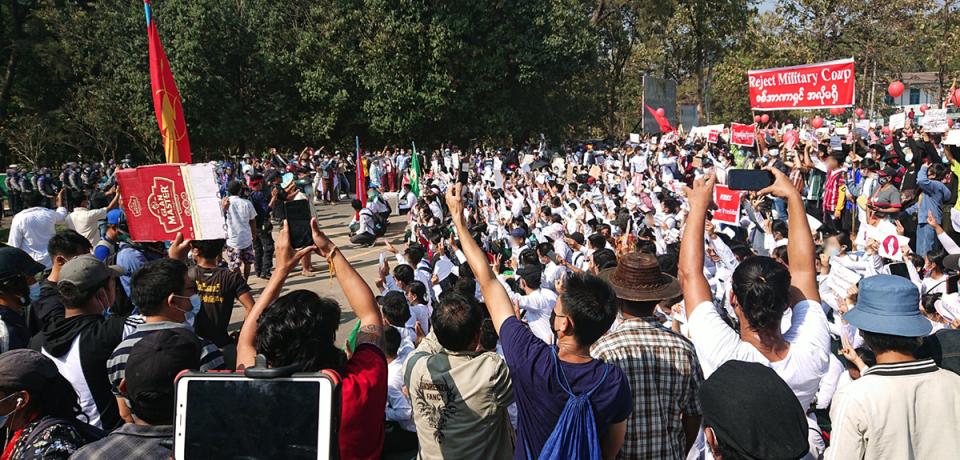
On 1 February this year, the army carried out a “preventive” coup d'état in a country where it already held most of the power. Since then it has been facing a massive movement of civil disobedience and seems to be preparing for direct military repression.
The army (Tatmadaw) has been in power in Burma since 1962. In 2008, it drafted a constitution giving it 25% of the seats (not subject to election) in the House of Representatives (Lower House, equivalent to the Parliament), as well as the House of Nationalities1 (Upper House) and allowing it to appoint the ministers of defence, cross-border affairs and interior, as well as a vice-president. It is not subject to civil control and has immense economic interests. It grants itself the right to arbitrate all legal and constitutional affairs of the country. The military has a de facto veto over any reform that it does not like, because amending this Constitution requires the agreement of 75% of parliamentarians, and it is easy for them to find support.
There is probably more than one reason for the putsch of 1 February, including the personal ambitions of Chief of Staff Min Aung Hlaing, who is about to reach retirement age (65) and wants to enter politics. His future is threatened by the pitiful results of the army party, the Union, Solidarity and Development Party (USDP), against the National League for Democracy (NLD) in the legislative elections of November 2020. Like Donald Trump, the junta finally declared that the results of the election could not be true. Shortly before the inauguration of the parliamentarians, it arrested leaders of the League, including the head of state and Aung San Suu Kyi.-
In 2015 the NLD, led by long-imprisoned Nobel Peace Prize winner Aung San Suu Kyi, won the parliamentary elections. This led to an agreement between the NLD and the military. It was supposed to initiate a “democratic transition”, but did not include any mechanism to allow it, such as a constitutional reform deconsecrating military power (which could only be done with their agreement!). The much-heralded transition did not take place.
Moreover, the military took advantage of the agreement reached in the wake of the legislative elections. This was particularly the case in 2017, when the army, under the aegis of General Min Aung Hlaing, massacred the Rohingyas, a largely Muslim minority, to make way for Indian and Chinese investments, provoking the exodus of more than 700,000 refugees. On this occasion, they received the unconditional support of Aung San Suu Kyi, not out of opportunism, but because she is a Bamara ethnonationalist (the majority ethnic group in Burma). On this occasion, Suu Kyi definitively lost the democratic credentials she had acquired during her long detention. Moreover, aware of China's economic and strategic weight, like the military, she is courting Beijing, without being its agent.
The crisis was therefore not about political orientations, but about the question of the presidency and the institutions. According to the Constitution, the presidency must be returned to a civilian personality, but the military has prevented Aung San Suu Kyi from acceding to this post by introducing a tailor-made written clause, namely the prohibition for people married to foreigners or with foreign children to accede to political functions (which is her case). Officially an “adviser”, Suu Kyi was therefore not the Head of State in title, although she was in practice.
The successive electoral successes of the NLD strengthened her hand, while the clear failure of the USDP weakened that of General Min Aung Hlaing. The putsch aims to bring a halt to this process that undermined the authority of the army. For a large part of the population, resistance to the coup is therefore being carried out in the name of the electoral legitimacy of the League and Suu Kyi.
The rejection of the putsch mobilised a wide range of social milieux (healthworkers, civil servants, the middle classes, private sector employees, entrepreneurs, shopkeepers, etc). It is carried by the youth, called “Generation Z”, who master social networks, show the same inventiveness as in Thailand, use street theatre, show the same courage, use the same symbol: the three fingers pointed to the sky. They astonish older people! Other actors in the resistance, the “88 Generation” (the year of a great antidictatorial struggle crushed in a bloodbath) with Ko Min Ko Naing as its figurehead, as well as the Civil Disobedience Movement (CDM) and, of course, the NLD, the first target of military repression.
Another very important aspect in this multi-ethnic country is that mobilizations against the putsch took place in most of the territories with a majority of “minorities”: Kachin, Kayah, Karen, Chin, Rakhine, Mon, Shan...
The ruling junta has tried to stifle protest by betting on its exhaustion, blocking its Internet communications, arresting a growing number of politicians and demonstrators, and repressing (one young woman was killed). To no avail. At the time this article is written, it is mobilizing the army, and not just the police, tanks are positioning themselves in the big cities. The first international solidarity initiatives have been taken, especially in South-East Asia. There is an urgent need to strengthen them.
- 1Burma is divided into 7 Regions which bring together the main ethnic group of the country: the Bamars; as well as 7 States: Kachin, Kayah, Kayin, Chin, Mon, Arakan, Shan which each correspond to one of the other main ethnic groups.